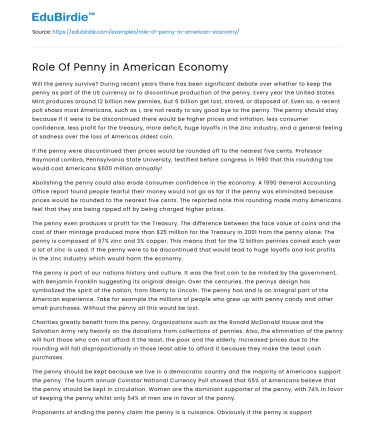Will the penny survive? During recent years there has been significant debate over whether to keep the penny as part of the US currency or to discontinue production of the penny. Every year the United States Mint produces around 12 billion new pennies, but 6 billion get lost, stored, or disposed of. Even so, a recent poll shows most Americans, such as I, are not ready to say good bye to the penny. The penny should stay because if it were to be discontinued there would be higher prices and inflation, less consumer confidence, less profit for the treasury, more deficit, huge layoffs in the zinc industry, and a general feeling of sadness over the loss of Americas oldest coin.
If the penny were discontinued then prices would be rounded off to the nearest five cents. Professor Raymond Lombra, Pennsylvania State University, testified before congress in 1990 that this rounding tax would cost Americans $600 million annually!
Save your time!
We can take care of your essay
- Proper editing and formatting
- Free revision, title page, and bibliography
- Flexible prices and money-back guarantee
Abolishing the penny could also erode consumer confidence in the economy. A 1990 General Accounting Office report found people fearful their money would not go as far if the penny was eliminated because prices would be rounded to the nearest five cents. The reported note this rounding made many Americans feel that they are being ripped off by being charged higher prices.
The penny even produces a profit for the Treasury. The difference between the face value of coins and the cost of their mintage produced more than $25 million for the Treasury in 2001 from the penny alone. The penny is composed of 97% zinc and 3% copper. This means that for the 12 billion pennies coined each year a lot of zinc is used. If the penny were to be discontinued that would lead to huge layoffs and lost profits in the zinc industry which would harm the economy.
The penny is part of our nations history and culture. It was the first coin to be minted by the government, with Benjamin Franklin suggesting its original design. Over the centuries, the pennys design has symbolized the spirit of the nation, from liberty to Lincoln. The penny has and is an integral part of the American experience. Take for example the millions of people who grew up with penny candy and other small purchases. Without the penny all this would be lost.
Charities greatly benefit from the penny. Organizations such as the Ronald McDonald House and the Salvation Army rely heavily on the donations from collections of pennies. Also, the elimination of the penny will hurt those who can not afford it the least, the poor and the elderly. Increased prices due to the rounding will fall disproportionally in those least able to afford it because they make the least cash purchases.
The penny should be kept because we live in a democratic country and the majority of Americans support the penny. The fourth annual Coinstar National Currency Poll showed that 65% of Americans believe that the penny should be kept in circulation. Women are the dominant supporter of the penny, with 74% in favor of keeping the penny whilst only 54% of men are in favor of the penny.
Proponents of ending the penny claim the penny is a nuisance. Obviously if the penny is supported by a majority of Americans then it isnt a nuisance. Another argument for getting rid of the penny is that it is a waste of time to make but it isnt a waste of time to the hundreds of workers in the zinc industry, and it generates a profit for the Treasury so they defiantly dont mind printing pennies.
The penny should not be discontinued because it is such an important part of the economy. It should remain in circulation for a multitude of reasons including its cultural value, popularity, importance to the zinc industry and Treasury, and if it were to be discontinued there would be inflation in the economy which will lead to lower consumer confidence.






 Stuck on your essay?
Stuck on your essay?

